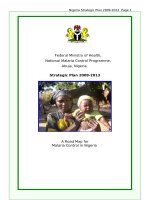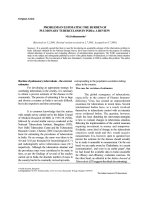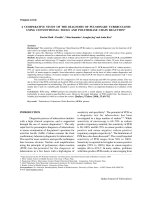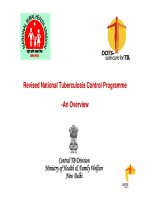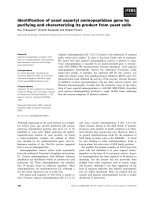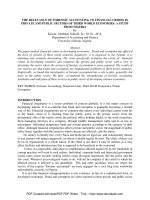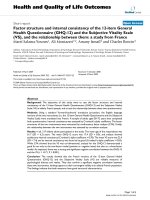TRENDS OF EXTRA-PULMONARY TUBERCULOSIS UNDER REVISED NATIONAL TUBERCULOSIS CONTROL PROGRAMME: A STUDY FROM SOUTH DELHI* pot
Bạn đang xem bản rút gọn của tài liệu. Xem và tải ngay bản đầy đủ của tài liệu tại đây (36.01 KB, 7 trang )
Indian Journal of Tuberculosis
Summary
Background & Objectives: Extra-pulmonary tuberculosis (EPTB) cases have been treated with a daily short course
chemotherapy (SCC) regimens in past. Following the success of Directly Observed Treatment-Short Course (DOTS)
programme over recent years, a study was carried out to determine prevalence of EPTB, to draw comparison between
annual case detection of pulmonary TB (PTB) and extra-pulmonary TB and to assess outcome of DOTS in EPTB in a
patient population of Delhi.
Methods: All consecutive EPTB cases of Delhi, diagnosed within LRS Institute of TB and Respiratory Diseases between
January 1996 to March 2003 and subsequently given DOTS at the area DOTS Centres, constituted the study group.
Results: Of overall 14185 cases, 2849 (20%) had EPTB. A significantly higher prevalence was observed in females (57%)
and in young age (mean + standard deviation of 23.4 + 12.8 years). Commonest involved site was lymph node (54%).
Whereas number of PTB and EPTB cases have increased over successive years, percentage of former declined significantly
through 84 in 1996 to 78 in 2002 and that of latter rose significantly through 16 to 22 correspondingly. EPTB to PTB
ratio changed significantly from 1:5 at start to about 1:3.5 at study-conclusion. Treatment completion was observed in
94% (1775/1885) of EPTB cases.
Conclusions: Under Revised National TB Control Programme (RNTCP) employing a DOTS strategy, annual case
detection has improved for both pulmonary and extra-pulmonary TB. Cure of infectious disease is likely to have resulted
in a relative rise of the annual EPTB case detection. DOTS effected an acceptable treatment outcome in EPTB case
management.
[Indian J Tuberc 2006;53:77-83]
Key words: Tuberculosis (TB), Extra-pulmonary tuberculosis (EPTB), Directly Observed Treatment- Short Course
(DOTS).
Original Article
TRENDS OF EXTRA-PULMONARY TUBERCULOSIS UNDER REVISED NATIONAL
TUBERCULOSIS CONTROL PROGRAMME: A STUDY FROM SOUTH DELHI*
V. K. Arora
1
and Rajnish Gupta
2
(Original received on 6.5.2005; Revised version received on 4.8.2005; Accepted on 16.8.2005)
INTRODUCTION
Extra-pulmonary tuberculosis (EPTB) is a
milder form of disease in terms of infectivity as
compared to pulmonary TB (PTB). Whereas sputum
can be easily obtained for the detection of disease in
lungs, diagnosis of EPTB is often difficult requiring
invasive and expensive serological/radiological
investigations. A category-wise drug treatment is
similar for the two forms of disease
1
. However, an
assessment of end point of cure is a problem with
EPTB. With the global rise of human immuno-
deficiency viral (HIV) infection over last decade,
studies have reported increasing association of EPTB
in HIV infected individuals
2,3
.
Prevalence of EPTB
has also been found to be high in paediatric TB cases
4
.
In the past, treatment of EPTB has been
carried out with a Short Course Chemotherapy
(SCC), which has given successful results in
tubercular affection of lymph nodes
5
,
pleura
2,6
,
male
7
and female
8,9
genitalia, ear
10
, skin
11
,
joints
12
etc. Even
the more serious forms like tubercular meningitis
(TBM) and miliary TB have been cured with it.
However, the treatment in past needed to be given
on a daily basis and delayed resolution, default or
failure occurred frequently owing to incorrect
prescriptions, inappropriate communication/drug
intake, erratic medical supplies and inaffordability.
A Directly Observed Treatment-Short Course
(DOTS) strategy was recommended for National
Tuberculosis Control Programmes globally by the
WHO about a decade back
1
, which was found to be
successful in all types of TB cases
13-23
.
Reports have
largely focused on smear positive pulmonary TB that
posed greater infectivity threat and accounted for a
higher morbidity and mortality than EPTB. In view
*Paper presented at the 58th National Conference on Tuberculosis & Chest Diseaes held in Mumbai in January 2004.
1. Former Director 2. Chest Physician
Department of TB & Respiratory Diseases, LRS Institute of TB & Respiratory Diseases, New Delhi.
Correspondence: Prof. (Dr.) V.K. Arora,Director Principal, Santosh Medical College & Hospital, Ghaziabad, (U.P.)
Tel: 95-120-3200937. E-mail:
Indian Journal of Tuberculosis
of the scarce data in respect of EPTB case-management
with DOTS, especially in Indian context, a study was
designed with the objectives: i) to determine prevalence
of EPTB, ii) to draw comparison between annual case
detection of PTB and EPTB, and iii) to assess outcome
of DOTS in extra-pulmonary form of disease in a
locality in Delhi.
MATERIAL AND METHODS
Present study is a retrospective analysis of
the patients’ record among a population of Delhi
living in the area catered by L.R.S. Institute of TB
and Respiratory Diseases. The record comprised of
parameters such as age, sex, site of disease (lymph
node, pleura, abdomen, bone, joint, genitalia, kidney,
skin, meninges and miliary), TB category (I, II or
III) and treatment outcome (completion, default,
failure, transfer out or death) for all consecutive
cases, diagnosed as having EPTB at the Institute and
administered DOTS at the area DOTS centres
between January 1996 and March 2003.
The diagnosis of EPTB cases was
established following the programme guidelines,
which required one culture positive specimen from
an extra-pulmonary site, or histological evidence, or
strong clinical evidence consistent with active EPTB
followed by a Medical Officer’s decision to treat
with a full course of anti-TB therapy
1
. The type of
investigation necessary to prove the presence of
disease depended upon the site of EPTB. Whenever
needed, invasive procedures were carried out under
an ultrasonic or a computed tomographic guidance
and the specimen subjected to a culture or
histopathology for evidence of TB. Following
diagnosis and categorisation, EPTB cases were
referred to their respective area DOTS centres, where
regular drug administration and follow up visits took
place as per the programme guidelines for a specified
duration of therapy
1
. Health education and motivation
to them was imparted within Institute prior to the
referral, as well as during the subsequent follow-up
visits at DOTS centres. The trained staff of these
centres, while administering the drugs, inquired about
the tolerance and possible side-effects, if any. The
number of PTB cases of area, who were diagnosed
and treated with DOTS at the DOTS centres, was
also recorded over the same study-period for a
comparative analysis with EPTB cases. Analysis of
treatment outcome was done for EPTB cases, whose
data was available.
RESULTS
Of the overall 14,185 area cases treated
under DOTS during study-period, 11,336 (80%) had
pulmonary TB and 2849 (20%) suffered from EPTB.
The latter comprised a higher number of females
(1615 (57%)) than males (1234 (43%)) constituting
a significantly different (p< 0.01) male: female ratio
of 1: 1.3. Age-distribution of EPTB cases (Table 1)
showed higher disease prevalence in the young age,
with a mean + standard deviation (SD) of 23.4 +12.8
years. Case-distribution with regard to the age as
well as the male: female ratio demonstrated
respectively similar annual trends. Commonest site
of EPTB involvement was lymph nodes (Table 2)
followed by affection of pleura. The category-wise
distribution placed highest number of study cases in
Category III (1943 or 68%) followed by those in
Categories I (537 or 19%) and II (369 or 13%).
Excluding an insignificant (p >0.05) dip in
number of cases detected in 1998 as compared to
the preceding year, detection of total, as well as, of
PTB and EPTB cases increased progressively over
the successive study years (Figure 1). Percentage
Table 1: Age distribution of extra-pulmonary
tuberculosis cases
V. K. ARORA AND RAJNISH GUPTA
Age (in years) Case-number (%)
<14
15-24
25-34
35-44
45-54
55-64
>65
Total
611 (21)
1074 (38)
725 (25)
274 (10)
92 (3)
45 (2)
28 (1)
2849 (100)
78
Indian Journal of Tuberculosis
of annual EPTB case detection (Figure 2) increased
significantly (p < 0.01) through 16 in 1996 to 22 in
2002, whereas that of PTB decreased significantly
(p < 0.01) through 84 to 78 during same time, though
change for the either was not uniformly similar over
intervening years. A further comparison of EPTB to
PTB case detection ratio between the base and final
years of study showed a significant (p < 0.05) fall in
the value of PTB cases from 1:5 to 1:3.5 (Figure 3).
The available outcome for the 1885 EPTB
cases, ranging from the milder lymphadenopathy to
the serious ones like meningeal or miliary TB etc,
who were treated with DOTS from January 1996 to
December 2001, showed treatment completion in
1775 (94%), default in 69 (3.7%), failure in 18 (1%),
transfer-out in 12 (0.7%) and death in 11 (0.6%)
cases. Drug tolerance was good. No significant drug
modifications were required due to side-effects such
as drug induced hepatitis etc.
DISCUSSION
The present study has shown a rising trend
of annual TB case detection in the area over recent
years for both PTB and EPTB cases. This rise is
believed to have occurred due to the extensive case
management efforts undertaken within the area under
Table 2: Site distribution of extra-pulmonary
tuberculosis cases
0
500
1000
1500
2000
2500
3000
3500
1996 1997 1998 1999 2000 2001 2002
Years
Number of detected cases
EPTB PTB Total
Fig. 1: Annual case detection trend in numbers
Fig. 2: Annual case detection trend in %
EXTRA-PULMONARY TB AND DOTS
0
10
20
30
40
50
60
70
80
90
1996 1997 1998 1999 2000 2001 2002
Years
% of detected cases
EPTB PTB
Involved site
Case-number (%)
Lymph node
Cervical
Axillary
Para-tracheal
Mediastinal
Pleural
Effusion
Empyema
Abdominal
Bone and joint
Genital
Renal
Ocular
Dermal
Meningeal
Miliary
Total
1530 (53.7)
1444
66
6
14
817 (28.7)
809
8
192 (6.7)
201 (7.0)
36 (1.3)
2 (0.1)
4 (0.2)
5 (0.2)
29 (1.0)
33 (1.1)
2849(100.0)
79
Indian Journal of Tuberculosis
DOTS programme over last decade, which have
enhanced the case enrollment of both forms of
TB
4,16,17,24,25
.
During same period, with a population
growth, the overall number of cases is also expected
to rise. HIV could be another contributory factor.
However, a recent study from LRS Institute has
found a low HIV sero-prevalence (0.9%) in area TB
cases (unpublished data) in comparison to other
regions of country outside Delhi
26,27
,
implying thereby,
that the factor is less likely to have played a significant
role in the observed trend of disease. Exact cause
for the rise in annual TB cases in area needs to be
better defined.
The study has shown that the percentage
of annual case detection has been gradually declining
for PTB (from 84 in 1996 to 78 in 2002) and rising
for EPTB (from 16 in 1996 to 22 in 2002). Both
observations appear to be linked because high cure
rate for new smear positive cases with DOTS over
last decade is likely to have reduced the TB
transmission level in area, thereby, accounting for
the decline in percentage of observed annual PTB
cases, as well as, the change in EPTB: PTB ratio
(from about 1: 5 at start to about 1: 3.5 at conclusion
of study). The decline of annual PTB case detection
percentage is assumed to have contributed in a relative
rise of the annual EPTB case percentage from the
expected prevalence of 7.4% (10/135)
28
under DOTS
programme to the significantly higher (p < 0.01)
observed level of 22%. More studies need to be
carried out, in order to determine the trend change
of EPTB and the factors responsible for this
especially desirable in developing countries, where
more TB cases exist and HIV is also on the rise.
Demographic characteristics of EPTB cases
have shown higher detection in females and in
patients of young age. Similar observations have been
made in past
29,30
. Recent Indian studies have also noted
a higher prevalence of EPTB in children than adults
(47% vs 16% respectively), with greater affection
0
1
2
3
4
5
6
1996 1997 1998 1999 2000 2001 2002
Years
Case detection (EPTB:PTB) ratio
EPTB PTB
Fig. 3: Annual trend of case detection ratio
V. K. ARORA AND RAJNISH GUPTA80
Indian Journal of Tuberculosis
of females (63% vs 33% respectively)
4
. In contrast,
a higher prevalence of PTB has been observed in
elderly than younger patients (16:1 respectively),
with male preponderance of disease (3:1
respectively)
24
.
Thus, demography of disease has not
changed over the years.
Most commonly involved EPTB site was
lymph node in more than one-half of patient-
population followed by the pleural effusion in more
than one-fourth of study cases. This finding is in
accordance with the epidemiological trend seen in
developed countries over past couple of decades,
where a rise in tubercular lymphadenitis
cases
has
been noticed after the onset of HIV era
29
. Although
a pre-dominance of lymphadenopathy among EPTB
cases in HIV and TB co-infected cases has been
recently reported from the capital
31
, more studies
need to be carried out, in order to ascertain the
association of tubercular lymphadenitis and HIV
infection within the region as well as within the
country.
It is notable that the observed outcome of
area, with a treatment completion of 94%, default
of <4% and failure of 1%, was better than that
reported for the country under the past and the
present NTP
17-19
.
Although, treatment outcome is
likely to have been influenced by the presence of a
large number of EPTB cases with the Category III
disease (as compared to the Categories I or II), the
observation of quality assurance in case management
is also believed to have been contributory. Whereas,
information, education and communication (IEC)
campaigns were conducted for the community
awareness, funds and administrative will adequately
supported the DOTS programme.
It was encouraging to note that DOTS could
satisfactorily treat all forms of EPTB without
requiring significant treatment modifications due to
drug-induced hepatitis. Its absence has been reported
earlier during the treatment of EPTB from the hilly
region of Himachal Pradesh, where presence of
hypoxia was believed to exist as an additional
contributory factor in causation of hepatic
impairment
32
. Exact reason for the observation in
EPTB needs to be explored. However, the absence
of side-effects is likely to have contributed in a good
treatment compliance.
Future Issues
The EPTB cases employed in service tend
to ignore their disease by giving priority to
occupational compulsions. Recent study from Delhi
has reported a high treatment success with service
utilisation of DOTS providers for those TB cases
engaged in job, study or household work
25
. Utility
of providers in delivering DOTS to TB cases has
been reported in other studies as well.
33,34
Similarly,
an involvement of private practitioners (PPs) in
DOTS programme has been suggested as another
way of increasing the case enrollment and treatment
success in TB control because usual PP practices
have been found to be ill advised and poorly
performed. Recent efforts to bring about a PP
participation in Delhi resulted in EPTB case detection
of 23% (143 out of 612 cases) and a treatment
completion of 68% (13 out of 19 cases in just 1
quarter)
35
. Feasibility of improved case detection
through involvement of PPs has been similarly
reported from Vietnam.
36
In a probable changing
scenario of disease, with an increasing EPTB
prevalence, role of DOTS providers and private
practitioners could become even greater, for, they
could assist in the further enhancement of case
enrolment, as well as, treatment success.
As of now, EPTB cases continue to be
referred for the management from a DOTS centre
to the tertiary institute. However, future health
policies may necessitate the placement of EPTB at a
greater level of priority than that in existence. DOTS
centres could be also strengthened to play a greater
role in EPTB case management.
In conclusion, annual case detection
has improved for both pulmonary and extra-
pulmonary TB under Revised National TB
Control Programme employing a DOTS
strategy. Cure of infectious disease is likely
to have contributed in a relative rise of the
annual EPTB case detection. DOTS effected
an acceptable treatment outcome in EPTB case
management.
EXTRA-PULMONARY TB AND DOTS 81
Indian Journal of Tuberculosis
Limitations
Present study did not undertake a carriage
of the HIV serology that has been presumed to be
responsible for the rise in the number of tubercular
lymphadenitis cases in developed countries. Another
limitation of this study related to the difficulty in
declaring an EPTB case cured in the absence of
objective evidence at end of treatment. A prolonged
follow-up of the treated cases could provide data
with regard to the number of relapses.
ACKNOWLEDGEMENTS
Authors are grateful to the RNTCP
department of Institute, which has been active in
conducting DOTS programme within Institute.
Thanks are also due to Mr. Anup Kumar Singh, for
carrying out a statistical analysis, and team of Anil
Awasthi, Rajni Kant and Pradeep for providing a
secretarial assistance.
REFERENCES
1. World Health Organisation. Treatment of tuberculosis:
Guidelines for national programmes. WHO, 1993: 1-
43.
2. Arora VK, Gowrinath K, Rao S. Extrapulmonary
involvement in HIV with special reference to
tuberculous cases. Indian J Tuberc 1995; 42: 27-32.
3. Barnes PF, Bloch AB, Davidson PTB, Snider Jr DE.
Tuberculosis in patients with human
immunodeficiency virus infection. New Eng J Med
1991; 324: 1644-1650.
4. Arora VK, Gupta R. Directly observed treatment for
tuberculosis. Indian J Paedtr 2003; 70: 885-889.
5. Arora VK, Varma R. Domiciliary short course
chemotherapy in tubercular lymphadenitis in field
conditions. Indian J Tuberc 1991; 38: 79-80.
6. Puri MM, Arora VK. Contralateral pleural effusion
during chemotherapy for tuberculous pleural effusion.
Med J Malaysia 2000; 55: 382-384.
7. Arora VK, Gowrinath K, Parsad BB. Tuberculous
ulcer of penis and effect of short course
chemotherapy. Indian J Chest Dis Allied Sci 1995;
37: 89-91.
8. Arora R, Rajaram P, Oumachigui A, Arora VK.
Prospective analysis of short course chemotherapy
in female genital tuberculosis. Int J Gynecol Obstet
1992; 38: 311-314.
9. Arora VK, Johri A, Arora R, Rajaram P. Tuberulosis
of the vagina in an HIV seropositive. Tubercle Lung
Dis 1994; 75: 239-240.
10. Arora VK, Gowrinath K. Tuberculous otitis media and
short course chemotherapy. Indian J Tuberc 1994;
41: 105-106.
11. Arora VK, Bedi RS. Acquired ichthyosis with tubercular
lymphadenitis. Indian J Tuberc 1988; 35: 201-202.
12. Arora VK, Verma R. Tuberculous rheumatism
(Poncet’s disease) : Three case reports. Indian J
Tuberc 1991; 38: 229-230.
13. Smith I. Stop TB: Is DOTS the answer ? Indian J
Tuberc 1999; 46: 81-90.
14. Chaulk CP, Moore-Rice K, Rizzo R, Chaisson RE.
Eleven years of community-based directly observed
therapy for tuberculosis. JAMA 1995; 274: 945-
951.
15. World Health Organisation. Research for action.
Understanding and controlling tuberculosis in India.
WHO, 2000.
16. Sarin R, Dey LBS. Indian national tuberculosis
programme: Revised strategy. Indian J Tuberc 1995:
42: 95-100.
17. Arora VK, Sarin R. Revised National Tuberculosis
Control Programme: Indian Perspective. Indian J
Chest Dis Allied Sci 2000; 42: 21-26.
18. Khatri GR. The Revised National Tuberculosis Control
Programme: A status report on first 1,00,000 patients.
Indian J Tuberc 1999; 46: 157-166.
19. Khatri GR, Freiden TR. The status and prospects of
tuberculosis control in India. Int J Tuberc Lung Dis
2000; 4: 193-200.
20. Central Tuberculosis Division. TB India 2003 –
RNTCP status report. New Delhi: Central TB Division
2003: 1-64.
21. Raduta M. Prophylactic measures in tuberculosis
hotbeds. Pneumologia 2001; 50: 159-166.
22. Norva PY, San KK, Bakhim T, Rith DN, Ahn DI,
Blanc L. DOTS in Cambodia. Directly observed
treatment with short-course chemotherapy. Int J
Tuberc Lung Dis 1998; 2: 44-51.
23. Wu J, Xiong G, Feng S, et al. Study on epidemic
trend and control policy of tuberculosis in Sichuan
province. Zhonghua Jie He He Hu Xi Za Zhi 2002;
25: 12-14.
24. Arora VK, Singla N, Sarin R. Profile of geriatric
patients under DOTS in Revised National Tuberculosis
Control Programme. Indian J Chest Dis Allied Sci
2003; 45: 231-235.
25. Arora VK, Singla N, Gupta R. Community mediated
domiciliary DOTS execution- A study from New Delhi.
Indian J Tuberc 2003; 50: 143-150.
26. Sharma SK, Saha PK, Dixit Y, Siddaramaiah NH, Seth
P, Pande JN. HIV sero-positivity among adult
tuberculosis patients in Delhi. Indian J Chest Dis Allied
Sci 2000; 42: 157-160.
27. Ahmed Z, Bhargava R, Pandey DK, Sharma K. HIV
infection seroprevalence in tuberculosis patients.
Indian J Tuberc 2003; 50: 151-154.
28. Central Tuberculosis Division. RNTCP at a glance.
New Delhi: Central TB Division, 1996: 1-18.
29. Iseman MD. Extra-pulmonary tuberculosis in
adults. In: Iseman MD, ed. A clinician’s guide to
tuberculosis. Philadelphia: Lippincott Williams &
V. K. ARORA AND RAJNISH GUPTA82
Indian Journal of Tuberculosis
Wilkins, 2000: 145-197.
30. Bedi RS, Thind GS, Arora VK. A clinico-pathological
study of superficial lymphadenopathy in northern
India. Indian J Tuberc 1987; 34: 189-191.
31. Kumar P, Sharma N, Sharma NC, Patnaik S. Clinical profile
of tuberculosis in patients with HIV infection/ AIDS. Indian
J Chest Dis Allied Sci 2002; 44: 159-163.
32. Arora VK. Hepatotoxicity with Rifamipicn and
Pyrazinamide containing regimens at moderate
altitude (2200 metres) in Himachal Pradesh. Indian J
Tuberc 1989; 36: 225-228
33. Wares DF, Akhtar M, Singh S. DOT for patients
with limited access to health care facilities in a
hill district of eastern Nepal. Int J Tuberc Lung
Dis 2001; 5: 732-740.
34. Klein SJ, Naizby BE. Creation of a tuberculosis directly
observed therapy provider network in New York City:
a new model of public health. J Public Health Manag
Pract 1995 Fall; 1: 1-6.
35. Arora VK, Sarin R, Lönnroth K. Feasibility and
effectiveness of a public-private mix project for
improved TB control in Delhi, India. Int J Tuberc
Lung Dis 2003; 7: 1131-1138.
36. Quy HT, Lan NTN, Lönnroth K, Buu TN, Dieu TTN,
Hai LT. Public-private mix for improved TB control
in Ho Chi Minh City, Vietnam: an assessment of its
impact on case detection. Int J Tuberc Lung Dis.2003;
7: 464-471.
EXTRA-PULMONARY TB AND DOTS 83
Essay Competition For Medical Students-2006
The Tuberculosis Association of India awards every year a cash prize of
Rs. 500/- to a final year medical student in India for an original essay on tuberculosis.
The subject selected for the year 2006 competition is ‘HIV and Tuberculosis’.
The essay should be written in English, typed double spaced, on foolscap size
paper and should not exceed 15 pages (approximately 3,000 words, including tables,
diagrams, etc.). Four copies of the typescript should be forwarded through the
Dean or Principal of a College/University to reach the Secretary-General,
Tuberculosis Association of India, 3 Red Cross Road, New Delhi-110 001, before
30th June, 2006 along with a certificate that the author is a final year medical
student
.
